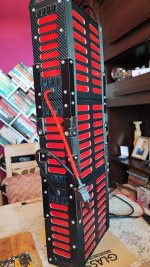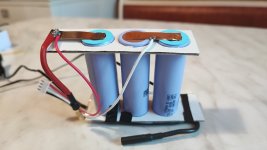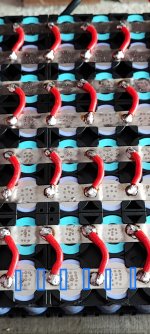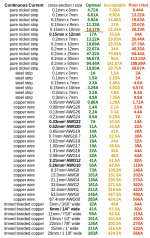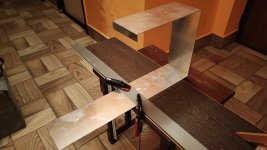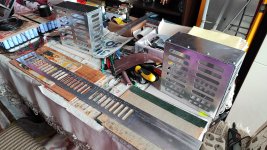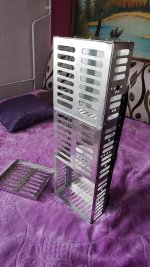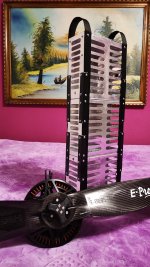Jackal21
10 mW
Hi, I've build an 2.8kw 24s8p battery (three 8s8p in series so I can charge them in parallel with hobby charger so no bms, for a paramotor project, using 21700 Samsung INR 40t3 4000mA, 35A, new cells from the well known company in NL.
Tested four of them from 2.5 to 4.20v and got 4.050 - 4.128mA in.
I didn't know about copper nickel sandwitch method so I've used 0.15x10mm pure nickel strip on the parallel groups on which I pre soldered 14awg wire for series connections.
For main output wires I used 8awg and QS8 antispark connectors, for series between packs I used 8awg and AS150 bullet connectors.
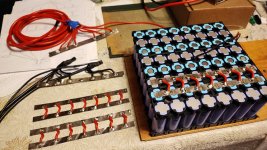
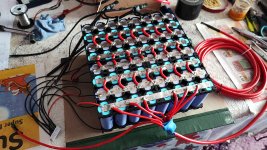


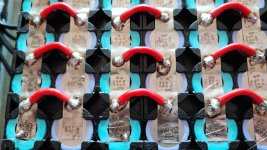
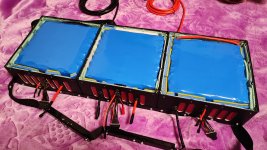
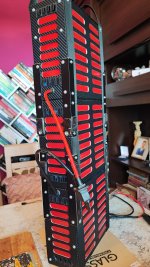
The load during level flight is 3.8kw, 5-6kw for climbing and 7-10kw takeoff. Tests and flight time so far around 27min, 3.5v/cell resting.
Long story short, at full power, 17kw the voltage drop is huge like 20v that is from 98v 4.15/cell to 78v 3.2v/cell. Which is not normal because a similar paramotor that uses even smaller batt like 24s6p molicels, instead of 8p, didn't report such voltage drop.
Also the temperature after 27min (from 4.15v to 3.5v) went to 55C, at an average of 5kw load, 60A, 7.5A/cell. The cells are rated to go to 44C at 10A.
I've used a cheap spot welder, was my first time, the welds are not that strong and I didn't avoid the middle as I should.
Do you think I have considerable losses somewhere? Or why this huge voltage drop? I was told that it could be the weak welds, the many soldering points or the nickel in parallel.
I was adviced to mount a thermometer probe on the nickel. ( I can't use the battery case open and check.)
If it's the nickel in parallel, could I weld another one on top or even 0.1 copper with steel plated nickel patches or is not necessary on the parallel?
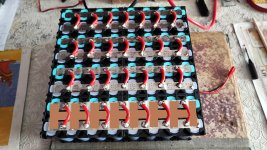
I've worked a lot at this project and would like to use the cells to their fullest and not overheat them.
Thank you!
First flight link here
Tested four of them from 2.5 to 4.20v and got 4.050 - 4.128mA in.
I didn't know about copper nickel sandwitch method so I've used 0.15x10mm pure nickel strip on the parallel groups on which I pre soldered 14awg wire for series connections.
For main output wires I used 8awg and QS8 antispark connectors, for series between packs I used 8awg and AS150 bullet connectors.







The load during level flight is 3.8kw, 5-6kw for climbing and 7-10kw takeoff. Tests and flight time so far around 27min, 3.5v/cell resting.
Long story short, at full power, 17kw the voltage drop is huge like 20v that is from 98v 4.15/cell to 78v 3.2v/cell. Which is not normal because a similar paramotor that uses even smaller batt like 24s6p molicels, instead of 8p, didn't report such voltage drop.
Also the temperature after 27min (from 4.15v to 3.5v) went to 55C, at an average of 5kw load, 60A, 7.5A/cell. The cells are rated to go to 44C at 10A.
I've used a cheap spot welder, was my first time, the welds are not that strong and I didn't avoid the middle as I should.
Do you think I have considerable losses somewhere? Or why this huge voltage drop? I was told that it could be the weak welds, the many soldering points or the nickel in parallel.
I was adviced to mount a thermometer probe on the nickel. ( I can't use the battery case open and check.)
If it's the nickel in parallel, could I weld another one on top or even 0.1 copper with steel plated nickel patches or is not necessary on the parallel?

I've worked a lot at this project and would like to use the cells to their fullest and not overheat them.
Thank you!
First flight link here


